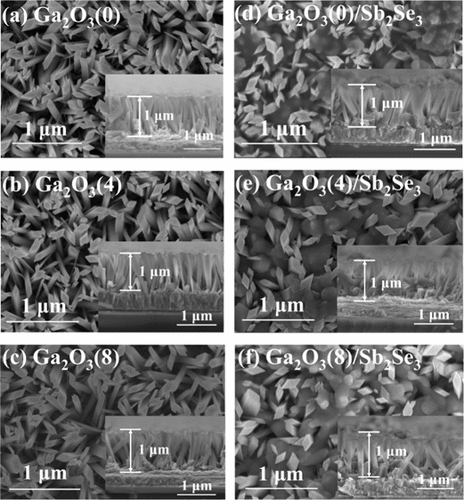

【Device Papers】Enhancing the Performance of Broadband Sb₂Se₃/Ga₂O₃ Self-Powered Photodetectors via Modulation of Ga₂O₃ Surface States and Their Application in All-Day Corona Detection
日期:2025-06-16阅读:316
Researchers from the Tianjin University of Technology have published a dissertation titled "Enhancing the Performance of Broadband Sb2Se3/Ga2O3 Self-Powered Photodetectors via Modulation of Ga2O3 Surface States and Their Application in All-Day Corona Detection" in ACS Applied Materials & Interfaces.
Abstract
The technology for photodetection and localization of corona discharge typically necessitates the integration of various photodetectors (PDs) with different photoresponse bands and relies on external power supplies. A self-powered PD was fabricated utilizing the Sb2Se3/Ga2O3 heterojunction, exhibiting a broadband photoresponse from solar-blind ultraviolet (SBUV) to visible (Vis) and near-infrared (NIR) bands. The surface states of Ga2O3 nanorod array (NR) films were modulated by treatment with hydrogen peroxide (H2O2) solution for different periods of time to suppress the interface recombination of photogenerated carriers in type-I heterojunctions. The H2O2 treatment resulted in increased hydroxyl groups (−OH) and decreased oxygen vacancies in Ga2O3 NRs. The −OH can facilitate oxygen molecule (O2) adsorption in Ga2O3 NRs and form O2– to consume photogenerated holes to reduce the recombination of photogenerated carriers. However, the decrease of oxygen vacancies will cause a decline in the concentration of electrons in Ga2O3 NRs to hinder the carrier transport. Ultimately, the optimized Al/Sb2Se3/Ga2O3/FTO PD, subjected to H2O2 treatment for 4 min, demonstrated responsivities of 3.3, 130, and 180 mA/W under 254, 525, and 850 nm light illumination without applying a bias voltage, respectively. The utilization of oxygen adsorption and desorption processes to regulate the recombination of photogenerated carriers at the interface is an effective strategy for improving the performance of I-type heterojunction self-powered PDs. An approach was conceptually proposed for all-day real-time corona discharge monitoring in high-voltage transmission lines by utilizing the broadband photoresponse characteristic of PDs. The SBUV photoresponse was applied for the capture of SBUV light signals generated by corona discharge. The photoresponse in Vis and NIR light bands was employed to provide background information on corona discharge in both strong light conditions during daytime and weak light conditions during nighttime. The results provide a low power and miniaturized solution for the digitalization of the Power Internet of Things (IoT) and enable real-time monitoring of high-voltage transmission lines.
DOI:
https://doi.org/10.1021/acsami.5c06657


